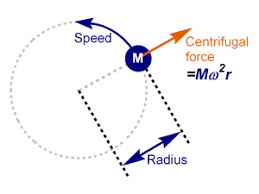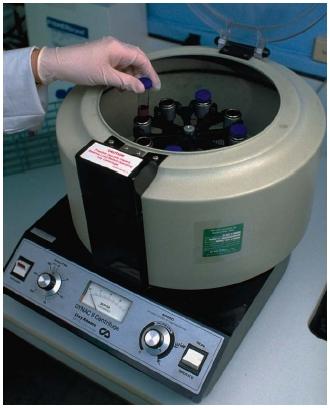Centrifuge is a lab equipment which used to separate suspension using centrifugal force. In other words it can separate a mixture of liquids or mixture of liquid and solid partials using centrifugal force.
Theory of operation

When centrifuge start above centrifugal fore applied on each particle in the liquid mixture. According to above equation, first segmentations occurs with most weight particle then lighter and so on.
Types of centrifuge.Centrifuges categories according to their speed or rotary arrangement. Generally speed of centrifuge is measured by RPM, revaluation per minutes.

Practical applications.

Safety implemented by the manufacturer.
The centrifuge is can be harmful because the rotter will rotate at very high RPM. So additional protections has implemented by all manufacturer to protect users.
1. Door cannot open while operation.
2. Thermal protection if an accidentally heat rotter
3. Only use accessories intended for use in your particular centrifuge, as recommended by your centrifuge supplier.
Planed Preventive Maintenance (PPM)
These are common things have to be considered on PPM but some mandatory things may include in manufacturer's service manual, they depend on the manufacturer and can't predefine for each and every production.
1. Clean and lubricate rotor pins.
2. Check any abnormal sound while working due to rotary aged. If so please replace necessary spares under supervision of BME.
3. Check for the door safety. Most of the machine door latch will not open up without the main power.
4. Check for leakage current.
5. check the horizontal level using bubble level.
Good Centrifuge Practice
Theory of operation
When centrifuge start above centrifugal fore applied on each particle in the liquid mixture. According to above equation, first segmentations occurs with most weight particle then lighter and so on.
Types of centrifuge.Centrifuges categories according to their speed or rotary arrangement. Generally speed of centrifuge is measured by RPM, revaluation per minutes.

- Fixed angle- angle between sample container and rotational axis remain unchanged while rotating
- Swinging head- angle between sample container and rotational axis changed with respect to the speed of rotter.
- Hematocrit- centrifuge which use to measure the red blood cells in while blood.
- Ultra centrifuge- rotary speed comes to 30,000 rpm.
Practical applications.
- Blood separation in hospital laboratory
- General chemistry, biochemistry laboratory sample preparation.
- Isotopic separation which used to

Safety implemented by the manufacturer.
The centrifuge is can be harmful because the rotter will rotate at very high RPM. So additional protections has implemented by all manufacturer to protect users.
1. Door cannot open while operation.
2. Thermal protection if an accidentally heat rotter
3. Only use accessories intended for use in your particular centrifuge, as recommended by your centrifuge supplier.
Planed Preventive Maintenance (PPM)
These are common things have to be considered on PPM but some mandatory things may include in manufacturer's service manual, they depend on the manufacturer and can't predefine for each and every production.
1. Clean and lubricate rotor pins.
2. Check any abnormal sound while working due to rotary aged. If so please replace necessary spares under supervision of BME.
3. Check for the door safety. Most of the machine door latch will not open up without the main power.
4. Check for leakage current.
5. check the horizontal level using bubble level.
Good Centrifuge Practice
Centrifuges can be potentially dangerous. Therefore it is vital that they are properly maintained and used correctly.
- Always run with a full compliment of buckets. Failure to do so can distort rotor.
- Ensure the rotor and all lids are tightened correctly before use.
- Samples should be diametrically distributed evenly around the buckets as shown.
- keep buckets clean and dry at all times.
- Only clean buckets in a neutral pH cleaner. Do not use strong alkalis, acids or chloros.
- Do not under any circumstances scratch the protective anodised surface of the bucket. Light use of a plastic scouring pad is acceptable in extreme cases.
No comments:
Post a Comment